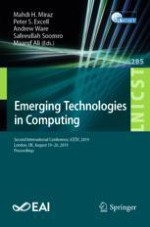2019 | Buch
Emerging Technologies in Computing
Second International Conference, iCETiC 2019, London, UK, August 19–20, 2019, Proceedings
herausgegeben von: Mahdi H. Miraz, Prof. Peter S. Excell, Andrew Ware, Safeeullah Soomro, Maaruf Ali
Verlag: Springer International Publishing
Buchreihe : Lecture Notes of the Institute for Computer Sciences, Social Informatics and Telecommunications Engineering
